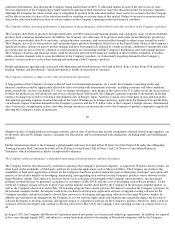Apple 2002 Annual Report Download - page 30
Download and view the complete annual report
Please find page 30 of the 2002 Apple annual report below. You can navigate through the pages in the report by either clicking on the pages listed below, or by using the keyword search tool below to find specific information within the annual report.
margins, frequent introduction of new products, short product life cycles, continual improvement in product price/performance characteristics,
price sensitivity on the part of consumers, and a large number of competitors. Over the past several years, price competition in the market for
personal computers has been particularly intense. The Company's competitors who sell Windows-based personal computers have aggressively
cut prices and lowered their product margins in order to gain or maintain market share in response to weakness in demand for personal
computing products that began in the second half of calendar 2000. The Company's results of operations and financial condition have been, and
in the future may continue to be, adversely affected by these and other industry-wide pricing pressures and downward pressures on gross
margins.
The personal computer industry has also been characterized by rapid technological advances in software functionality, hardware performance,
and features based on existing or emerging industry standards. Further, as the personal computer industry and its customers place more reliance
on the Internet, an increasing number of Internet devices that are smaller and simpler than traditional personal computers may compete for
market share with the Company's existing products. Several competitors of the Company have either targeted or announced their intention to
target certain of the Company's key market segments, including consumer, education, professional and consumer digital video editing, and
design and publishing. Additionally, several of the Company's competitors have introduced or announced plans to introduce products that
mimic many of the unique design, technical features, and solutions of the Company's products. The Company has many substantial
competitors, many of whom have greater financial, marketing, manufacturing, and technological resources, as well as broader product lines and
larger installed customer bases than those of the Company. Additionally, there has been a trend towards consolidation in the personal computer
industry that has resulted in larger and potentially stronger competitors in the Company's markets.
The Company is currently the only maker of hardware using the Mac OS. The Mac OS has a minority market share in the personal computer
market, which is dominated by makers of computers utilizing Microsoft's Windows operating systems. The Company's future operating results
and financial condition are substantially dependent on its ability to continue to develop improvements to the Macintosh platform in order to
maintain perceived design and functional advantages over competing platforms, including Windows.
The Company has higher research and development and selling, general and administrative costs, as a percentage of revenues, than many of
competitors.
The Company's ability to compete successfully and maintain attractive gross margins is heavily dependent upon its ability to ensure a
continuing and timely flow of innovative and competitive products and technology to the marketplace. As a result, the Company incurs higher
research and development costs as a percentage of revenue than its competitors who sell Windows-based personal computers. Many of these
competitors seek to compete aggressively on price and maintain very low cost structures. Further, as a result of the expansion of the Company's
Retail segment and costs associated with marketing the Company's brand including its unique operating system, the Company incurs higher
selling costs as a percent of revenue than many of its competitors. If the Company is unable to continue to develop and sell innovative new
products with attractive gross margins, its results of operations may be materially adversely affected by its operating cost structure.
36
The Company must successfully manage frequent product introductions and transitions.
Due to the highly volatile nature of the personal computer industry, which is characterized by dynamic customer demand patterns and rapid
technological advances, the Company must continually introduce new products and technologies and enhance existing products in order to
remain competitive. The success of new product introductions is dependent on a number of factors, including market acceptance, the
Company's ability to manage the risks associated with product transitions, the availability of application software for new products, the
effective management of inventory levels in line with anticipated product demand, the availability of products in appropriate quantities to meet
anticipated demand, and the risk that new products may have quality or other defects in the early stages of introduction. Accordingly, the
Company cannot determine in advance the ultimate effect that new products will have on its sales or results of operations.
During 2001, the Company introduced a new client operating system, Mac OS X, and delivered its first major upgrade, Mac OS X version
10.1. During 2002, the Company delivered another major upgrade, Mac OS X Jaguar. Inability of the Company to improve the performance
and functionality of Mac OS X, advance customer acceptance of the new operating system and its upgrades, or obtain the continued
commitment of software developers to transition existing applications to run on Mac OS X or create new applications to run on Mac OS X,
may have an adverse impact on the Company's operating results and financial condition.
Because orders for components, and in some cases commitments to purchase components, must be placed in advance of customer orders, the
Company faces substantial inventory risk.
The Company records a write-down for inventories of components and products that have become obsolete or are in excess of anticipated
demand or net realizable value and accrues necessary reserves for cancellation fees of orders for inventories that have been canceled. Although
the Company believes its inventory and related provisions are adequate, given the rapid and unpredictable pace of product obsolescence in the
computer industry, no assurance can be given the Company will not incur additional inventory and related charges. In addition, such charges
have had, and may again have, a material effect on the Company's financial position and results of operations.
























